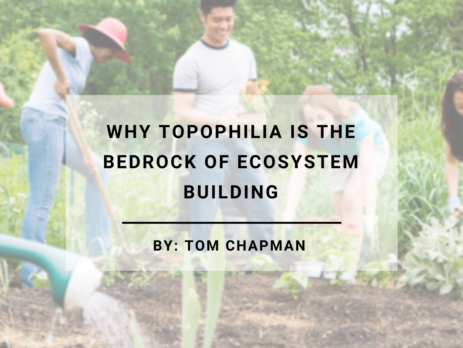Topophilia means “the love of place.” This is eloquently described in many texts, including “The Startup Community Way” by Ian Hathaway and Brad Feld. Near the end of the book, it states: “Given the absence of a blueprint [to build an ecosystem], the only path forward is a process of trial and error, learning from failures and building on a city’s unique strengths. Cultivating a deep love of place (called topophilia) helps startup community participants endure the inevitable ups and downs.”
In this way, the enduring lifeblood of the ecosystem goes beyond measurables to a fundamental understanding and love of the place. Why do people love places? Why are people willing to work to improve a place for community? Essentially, these have been eternal human questions, but rather than emulation, good ecosystems start with the fundamentally unique character of a people and place.
Topophilia and Systems Thinking
This is one way that systems thinking can go astray when the desire is to build “the next Silicon Valley.” Before we go too far, let’s talk about systems thinking. Systems thinking, according to Tech Target is “a holistic approach to analysis that focuses on the way that a system’s constituent parts interrelated and how systems work over time and within the context of larger systems.” This definition identifies three key elements of systems thinking. First, the constituent parts depend on context and are enabled and empowered by the other parts. Second, time affects and has a consequence for processes in systems. Not everything happens on a project basis or all at once. Third, most systems are part of bigger systems. So, a process in a company will interact with many other processes. The same is true of an ecosystem activity; it’s part of a wider ecosystem that has many other activities acting in concert.
Some believe that this thinking process fails because it attempts to replicate the unique nature of a place or a time, which is accurate. But, beyond that, many witness current success and miss the fundamental starting points – which go far deeper than a research university or innovative discovery. At its heart, ecosystems reside in the builders’ hearts – not in the institutions associated with the ecosystem. This individual culture within an entrepreneurial ecosystem is not well understood but explains the unique verve of many great ecosystems – from Silicon Valley to Israel.
This phenomenon is not well understood because too often we rush right past the community to the outcomes. We measure the outcomes and the successes – we do not see the lines of safety, trust, and experience that line the womb of the successful ecosystem. To this end, the community builders of Fort Worth enlisted my aid to help build a metric about community and topophilia.
An Imperfect Measurement
The topophilia metric is crude – but with all attempts to measure difficult things, it is a starting point. My hope is that it will yield other more refined efforts. But, let me be the first to say that I think the measurement is not the point – it is the conversations that it prompts about what makes a place special – worthy of love. We are taking consistent data and attempting to place meaning to it. It is not the measurement that creates the meaning – but the attempt to identify some of the myriad elements that make places special.
In my work, I have worked in over forty locales. Many of these places believe themselves unworthy of building a great ecosystem because they are lacking. But, the people who hire me and who are the leaders believe in their place. This is topophilia.
What’s in the Algorithm?
Our preliminary metrics involve community spending, asset development, and other elements that were discussed as reasons that make Fort Worth different and special. As with most analysis that is intended to be replicated and built upon, the fundamental analysis is built on replicable sources that are apples to apples comparisons for different regions and communities. For example, one key source is the Quarterly Census of Employment and Wages (QCEW). This source allows a user to breakdown employment, establishments and wages for various sectors of the economy.
We believe that some of topophilia can be captured using NAICS 71 (Arts, Entertainment, and Recreation). For Tarrant County, there are 622 establishments, employment over 17k, and wages of more than $650m per year. We can compare that data to other counties – giving us an easy to compare tool that allows us to build similar datasets for various places. However, this is not a measure of topophilia by itself. Instead, the measurement needs to include other elements of important information – such as spending and individual information about residents and the landscape of communities. Not every community has every desired piece of information, and so frequently, measurements of this kind will use a less desired by easier to identify algorithm of information.
How Does Fort Worth Score on Topophilia?
In general, Fort Worth and Tarrant County overlap enough that we treated the data as comparable. This was true of other communities in Texas such as Harris and Houston and Bexar and San Antonio. In doing this analysis, Fort Worth consistently scored in the middle.
But other communities fluctuated between really high scoring in some categories, and low scoring in others. For example, El Paso and San Antonio had much smaller per capita spending on activities – but higher amounts of main street business entrepreneurship and tourism, respectively. See the topophilia metric and how Fort Worth compares to major Texas cities on other metrics on the Sparkyard ecosystem dashboard.
How Can Fort Worth Improve its Love of Place?
There is no one strategy to improve topophilia. A previous post by Sparkyard argued for increased investment in support to the local creative class, citing research that shows the high correlation between a thriving creative class and booming, robust entrepreneurial ecosystems. Additionally, a focus on building out more around key assets, such as the Stockyards, may be one path to increase tourism (a key element of our measurement when supported by local employment and spending). But being intentional about providing focused investment (particularly Main Street commercial loans) could help build a stronger Main Street and ownership of these businesses in key areas important for topophilia.
However, these are elements that can be measured easily and do not measure the only ways to think about a community and its people’s love. Moreover, it implies financial measurements around love. How many times has this mistake been made in human history?
So, understand that we can anticipate the many negative reactions to our measurement for topophilia, but we also believe it to be worthwhile to measure. In the conversation comes the opportunity to identify key aspects of topophilia that may be more difficult to measure but may lead to deeper truths regarding ecosystem building. We consider this only the beginning of the story for this metric. There is more work to be done.
Entrepreneurial ecosystem builders do what they do because they love their places. The work is hard, the hours are long and the rewards are not always clear. But their love of place – their topophilia – keeps them going.

About the Author
Tom Chapman is a long-time entrepreneurial ecosystem builder from Omaha, Nebraska – where he owns and operates a consulting company called Chapman & Company. He is also a many-time entrepreneur that currently operates a cosmetics and beauty business, called Peeq. He has deep expertise in entrepreneurship and in measuring hard to measure elements, such as topophilia.



